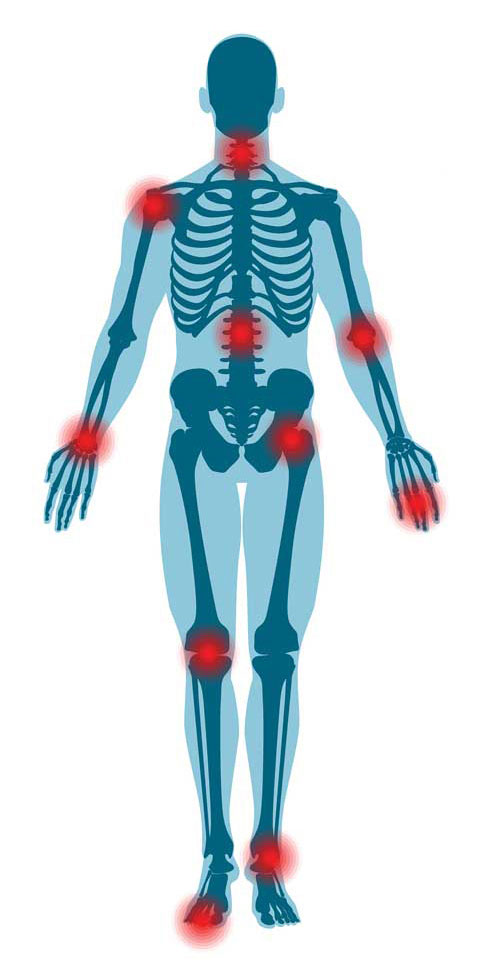 Arthritis is a group of over 100 conditions affecting joints or tissues surrounding joints. Pain, stiffness, and diminished range of motion around the affected area are common symptoms of most types of arthritis.1,2 About 58.5 million adults in the United States have arthritis,1 and it more commonly affects women than men.2
Arthritis is a group of over 100 conditions affecting joints or tissues surrounding joints. Pain, stiffness, and diminished range of motion around the affected area are common symptoms of most types of arthritis.1,2 About 58.5 million adults in the United States have arthritis,1 and it more commonly affects women than men.2
Types of arthritis
The most common type of arthritis is osteoarthritis, appearing most frequently in the hands, hips, knees, and spine, although it can develop at any joint. In osteoarthritis, cartilage breaks down, bones in the affected joint weaken, the joint space is narrowed, and inflammation damages the lining of the joint. Symptoms of osteoarthritis include joint pain, stiffness, limited mobility or flexibility, and swelling. Older age increases the risk of developing osteoarthritis, but it can also occur in younger people due to injuries or overuse. Other risk factors of osteoarthritis include obesity, inadequate physical activity, and family history.2–4
Rheumatoid arthritis (RA) is a form of autoimmune inflammatory arthritis, wherein the immune system attacks the synovium, or joint lining, causing inflammation. It commonly occurs in the hands, wrists, knees, and ankles. RA can also affect the heart, lungs, and eyes. Although researchers have not yet determined why RA develops, it is believed that those with RA have genes that can be activated by an environmental trigger (e.g., virus, bacteria, emotional or physical stress). Symptoms include joint pain, stiffness, tenderness, or swelling in more than one joint and/or in the same joint on both sides of the body; morning stiffness lasting longer than 30 minutes; small joints being affected first; fever; and fatigue. Risk of developing RA increases with older age, being female, family history, smoking, and obesity.5,6
Other forms of autoimmune inflammatory arthritis include psoriatic arthritis, scleroderma, axial spondyloarthritis, juvenile idiopathic arthritis, and lupus. Like RA, these types of arthritis involve the immune system attacking the body, potentially due to an environmental trigger, thus causing inflammation and joint pain.2
Psoriatic arthritis occurs alongside psoriasis, and results in itchy, painful red patches of skin or silver buildup of dead skin cells. It frequently develops in the fingers, wrists, ankles, and knees. Nail disease can also occur, characterized by cracking, pitting, white spots, and lifting from the nail bed.7
Scleroderma causes the skin and other connective tissues to harden and thicken.3
Axial spondyloarthritis causes pain and swelling in the spine, as well as the joints connecting the spine to the pelvis. Over time, this disease can causes the bones of the spine to fuse together.3,8
Juvenile idiopathic arthritis occurs in children and can affect bone development.3
Lupus results in flares of inflammation, which can harm joints, organs, and tendons.3,9 Aside from joint pain, common symptoms include butterfly rash on the cheeks and nose, fatigue, mouth sores, and light sensitivity.9
Gout is caused by a buildup of uric acid crystals in a joint, typically the big toe. Uric acid is produced by the breakdown of purines. This uric acid accumulation can cause sudden flares of intense pain. However, some people with high levels of uric acid do not have gout, and some people with lower levels of uric acid experience gout flares, suggesting the role of other potential triggers, such as osteoarthritis damage or disruptions in the gut microbiome.2,10
Treatment
Although specific treatment methods may vary based on the individual and the type of arthritis, there are many common treatment and management strategies. Starting treatment early is key, especially for autoimmune inflammatory arthritis, in order to prevent or reduce permanent joint damage. Since arthritis cannot be cured, remission and pain reduction are typical treatment goals. A combination of regular physical activity, hot and cold therapies, a healthy diet, using assistive devices (e.g., canes, crutches), over-the-counter medications, and, when appropriate, losing weight can alleviate arthritis symptoms.1–3,11 For those with inflammatory arthritis, disease-modifying antirheumatic drugs (DMARDs) can help slow disease progression and treat problems related to the immune system. Corticosteroids can ease swelling and inflammation.3,11
Nutrition
A healthy diet is important for managing arthritis. Anti-inflammatory diets, such as the Mediterranean diet, are recommended to reduce inflammation and maintain healthy joints. Cold-water fish, colorful fruits and vegetables, olive oil, beans, and whole grains can help lower the levels of inflammatory markers in the blood.12 People with gout should avoid foods that are high in purines, which includes red meat, organ meats, some seafood, added sugars and sugary beverages, and alcohol (especially beer).2,12
Sources
- Centers for Disease Control and Prevention. FAQs about arthritis. Reviewed 12 Oct 2021. https://www.cdc.gov/arthritis/basics/faqs.htm. Accessed 4 Jan 2023.
Rath L. What is arthritis? Arthritis Foundation. Updated 9 Jun 2022. https://www.arthritis.org/health-wellness/about-arthritis/understanding-arthritis/what-is-arthritis. Accessed 4 Jan 2023.
Johns Hopkins Medicine. Arthritis. https://www.hopkinsmedicine.org/health/conditions-and-diseases/arthritis. Accessed 4 Jan 2023.
Centers for Disease Control and Prevention. Osteoarthritis (OA). Reviewed 27 Jul 2020. https://www.cdc.gov/arthritis/basics/osteoarthritis.htm. Accessed 4 Jan 2023.
Arthritis Foundation. Rheumatoid arthritis: causes, symptoms, treatments, and more. Updated 15 Oct 2021. https://www.arthritis.org/diseases/rheumatoid-arthritis. Accessed 4 Jan 2023.
Centers for Disease Control and Prevention. Rheumatoid arthritis (RA). Reviewed 27 Jul 2020. https://www.cdc.gov/arthritis/basics/rheumatoid-arthritis.html. Accessed 4 Jan 2023.
Arthritis Foundation. Psoriatic arthritis. https://www.arthritis.org/diseases/psoriatic-arthritis. Accessed 4 Jan 2023.
Arthritis Foundation. Axial spondylitis. https://www.arthritis.org/diseases/ankylosing-spondylitis. Accessed 4 Jan 2023.
Arthritis Foundation. Lupus. https://www.arthritis.org/diseases/lupus. Accessed 4 Jan 2023.
Centers for Disease Control and Prevention. Gout. Reviewed 27 Jul 2020. https://www.cdc.gov/arthritis/basics/gout.html. Accessed 4 Jan 2023.
Arthritis Foundation. Medications for arthritis. https://www.arthritis.org/health-wellness/treatment/treatment-plan/disease-management/medications-for-arthritis. Accessed 4 Jan 2023.
Paturel A. The ultimate arthritis diet. Arthritis Foundation. https://www.arthritis.org/health-wellness/healthy-living/nutrition/anti-inflammatory/the-ultimate-arthritis-diet. Accessed 4 Jan 2023.





